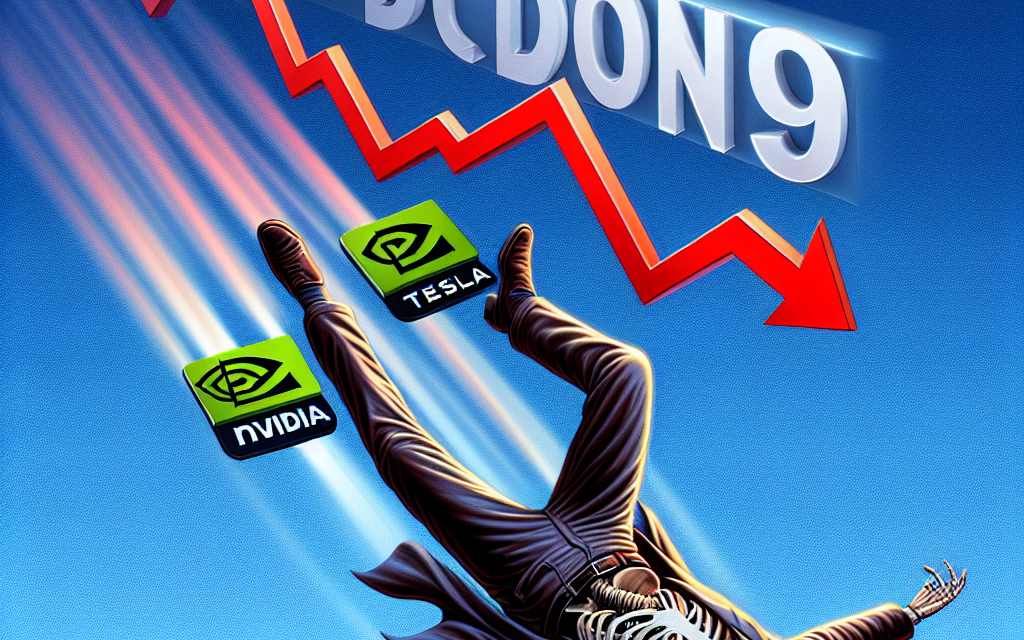“Dow Jones Futures Dip Further, Deepening Stock Market’s Woes as Nvidia and Tesla Tumble.”
Introduction
Dow Jones futures fell sharply, contributing to the ongoing decline in the stock market, which has faced significant losses in recent sessions. The downturn was exacerbated by notable declines in major tech stocks, including Nvidia and Tesla, as investors reacted to a combination of economic concerns and shifting market sentiment. This trend reflects broader anxieties about inflation, interest rates, and the potential for a slowdown in economic growth, prompting a cautious approach among traders and analysts alike.
Dow Jones Futures Decline: Analyzing the Impact on Investor Sentiment
As Dow Jones futures decline, the ripple effects on investor sentiment become increasingly evident, particularly in light of the recent downturn in the stock market. The persistent slide in major indices, including the Dow Jones Industrial Average, has raised concerns among investors, prompting a reevaluation of market strategies and risk tolerance. This decline is not merely a statistical anomaly; it reflects deeper economic uncertainties that are influencing market dynamics and investor behavior.
The recent performance of key stocks, such as Nvidia and Tesla, has further exacerbated the situation. Nvidia, a leader in graphics processing units and artificial intelligence technology, has seen its stock price falter amid broader market pressures. Similarly, Tesla, a pioneer in electric vehicles, has faced its own set of challenges, including supply chain disruptions and increasing competition. As these high-profile companies experience declines, investor confidence wavers, leading to a more cautious approach in the market.
Moreover, the decline in Dow Jones futures serves as a barometer for overall market sentiment. When futures are down, it often signals that investors are bracing for further losses, which can create a self-fulfilling prophecy. This phenomenon occurs as traders react to negative sentiment by selling off shares, thereby driving prices lower and reinforcing the prevailing pessimism. Consequently, the psychological impact of falling futures can lead to increased volatility, as investors grapple with uncertainty and fear of further declines.
In addition to individual stock performances, macroeconomic factors play a significant role in shaping investor sentiment. Concerns over inflation, interest rates, and geopolitical tensions have created a complex backdrop for market participants. As central banks navigate the delicate balance of stimulating growth while controlling inflation, investors remain on edge, uncertain about the future trajectory of monetary policy. This uncertainty can lead to heightened volatility in the stock market, as investors react to news and data releases with increased sensitivity.
Furthermore, the decline in Dow Jones futures may also reflect broader trends in investor behavior. In recent years, there has been a notable shift towards more cautious investment strategies, with many investors opting for safer assets in times of uncertainty. This trend is particularly pronounced among retail investors, who may be more susceptible to market fluctuations and emotional decision-making. As a result, the decline in futures could prompt a wave of selling among retail investors, further amplifying the downward pressure on stock prices.
As the market grapples with these challenges, it is essential for investors to remain vigilant and informed. Understanding the underlying factors contributing to the decline in Dow Jones futures can help investors make more informed decisions. By analyzing market trends, economic indicators, and individual stock performances, investors can better navigate the complexities of the current environment.
In conclusion, the decline in Dow Jones futures is a significant development that underscores the fragility of investor sentiment in the current market landscape. With high-profile stocks like Nvidia and Tesla facing challenges, and macroeconomic uncertainties looming large, investors must approach the market with caution. By staying informed and adapting to changing conditions, investors can better position themselves to weather the storm and capitalize on potential opportunities that may arise in the future.
Nvidia’s Stock Slide: Causes and Consequences for the Tech Sector
Nvidia’s recent stock slide has raised significant concerns within the tech sector, reflecting broader market trends that have contributed to the overall decline in stock prices. As one of the leading companies in the semiconductor industry, Nvidia’s performance often serves as a bellwether for the health of technology stocks. The company’s shares have experienced a notable downturn, which can be attributed to several interrelated factors, including macroeconomic pressures, shifts in consumer demand, and competitive dynamics within the industry.
One of the primary causes of Nvidia’s stock decline is the prevailing economic uncertainty that has gripped global markets. Rising interest rates, driven by central banks’ efforts to combat inflation, have created a challenging environment for growth-oriented companies. Investors are increasingly cautious, leading to a reevaluation of tech stocks that were previously considered high-flying. Nvidia, despite its strong fundamentals and leadership in graphics processing units (GPUs), has not been immune to this trend. As investors reassess their portfolios in light of economic conditions, Nvidia’s stock has faced downward pressure, contributing to the overall losses in the tech sector.
In addition to macroeconomic factors, shifts in consumer demand have also played a crucial role in Nvidia’s stock performance. The company has historically benefited from robust demand for its GPUs, particularly in gaming and data center applications. However, recent reports indicate a slowdown in consumer spending, particularly in discretionary categories such as gaming hardware. This decline in demand has raised concerns about Nvidia’s ability to maintain its growth trajectory, prompting investors to reconsider their positions. As a result, the stock has experienced increased volatility, reflecting the uncertainty surrounding its future prospects.
Moreover, competitive dynamics within the semiconductor industry have further complicated Nvidia’s situation. The rise of rival companies, particularly in the field of artificial intelligence and machine learning, has intensified competition for market share. Companies such as AMD and Intel have made significant strides in developing their own GPU technologies, which could potentially erode Nvidia’s dominance. This competitive landscape has led to fears that Nvidia may face challenges in sustaining its market leadership, thereby impacting investor sentiment and contributing to the stock’s decline.
The consequences of Nvidia’s stock slide extend beyond the company itself, as it has broader implications for the tech sector as a whole. A decline in Nvidia’s stock can lead to a ripple effect, influencing the valuations of other technology companies that are closely tied to its performance. Investors often view Nvidia as a proxy for the health of the semiconductor industry, and a significant drop in its stock price can lead to a broader sell-off in tech stocks. This interconnectedness underscores the importance of Nvidia’s performance in shaping market sentiment and investor behavior.
In conclusion, Nvidia’s stock slide is a multifaceted issue driven by economic uncertainty, shifts in consumer demand, and increased competition within the semiconductor industry. As the tech sector grapples with these challenges, the implications of Nvidia’s performance will likely continue to resonate throughout the market. Investors will be closely monitoring the company’s ability to navigate these turbulent waters, as its future performance could serve as a critical indicator of the broader health of the technology sector.
Tesla’s Market Struggles: What It Means for Electric Vehicle Stocks
Tesla’s recent market struggles have raised significant concerns not only for its investors but also for the broader electric vehicle (EV) sector. As one of the most prominent players in the EV market, Tesla’s performance often serves as a bellwether for other companies in the industry. The recent decline in Tesla’s stock price, compounded by broader market trends, has led to a ripple effect that is impacting the valuations and investor sentiment surrounding other electric vehicle manufacturers.
The decline in Tesla’s stock can be attributed to several factors, including increased competition, supply chain challenges, and changing consumer preferences. As more automakers enter the EV space, Tesla faces mounting pressure to maintain its market share. Companies such as Ford, General Motors, and newer entrants like Rivian and Lucid Motors are ramping up their production capabilities and introducing innovative models that appeal to a wider range of consumers. This intensifying competition has not only affected Tesla’s sales projections but has also led to a reevaluation of its growth potential, which is critical for maintaining investor confidence.
Moreover, supply chain disruptions, which have plagued many industries, have also affected Tesla’s production capabilities. The ongoing semiconductor shortage has hindered the company’s ability to meet demand, leading to delays in vehicle deliveries. As a result, investors are increasingly concerned about Tesla’s ability to sustain its growth trajectory in the face of these challenges. This uncertainty has contributed to the stock’s decline, prompting a broader reassessment of the EV market as a whole.
In addition to these operational challenges, changing consumer preferences are also playing a role in Tesla’s market struggles. As the EV market matures, consumers are becoming more discerning, seeking vehicles that not only offer electric powertrains but also advanced technology, safety features, and overall value. This shift in consumer behavior has led to increased scrutiny of Tesla’s pricing strategies and product offerings. If Tesla fails to adapt to these evolving preferences, it risks losing its competitive edge, which could further impact its stock performance and, by extension, the entire EV sector.
The implications of Tesla’s struggles extend beyond its own stock price. As Tesla’s market capitalization has a significant influence on the valuations of other electric vehicle manufacturers, a decline in its stock can lead to a broader downturn in the sector. Investors often look to Tesla as a benchmark for the health of the EV market, and any negative sentiment surrounding the company can create a ripple effect that impacts the stock prices of its competitors. Consequently, companies that are heavily reliant on investor confidence may find themselves facing increased volatility as a result of Tesla’s challenges.
In conclusion, Tesla’s recent market struggles serve as a critical indicator of the current state of the electric vehicle industry. The combination of heightened competition, supply chain issues, and shifting consumer preferences has created a challenging environment for the company. As Tesla navigates these obstacles, the repercussions are likely to be felt throughout the EV sector, influencing investor sentiment and stock valuations across the board. The future of electric vehicle stocks may hinge on how well Tesla can adapt to these challenges and whether it can maintain its position as a leader in the rapidly evolving automotive landscape.
The Ripple Effect: How Dow Jones Futures Influence Broader Market Trends
The fluctuations in Dow Jones futures serve as a significant barometer for the overall health of the stock market, influencing investor sentiment and market dynamics. When Dow futures decline, as seen recently, it often signals a broader trend of uncertainty and volatility that can ripple through various sectors. This phenomenon is particularly evident in the context of major companies like Nvidia and Tesla, whose stock prices are sensitive to market trends and investor confidence. As these tech giants experience declines, the repercussions can extend beyond their individual performance, affecting related industries and the market at large.
The relationship between Dow futures and the stock market is complex yet crucial. Dow futures are essentially projections of how the Dow Jones Industrial Average will perform when the market opens. A drop in these futures can lead to a cautious approach among investors, prompting them to reassess their portfolios and investment strategies. This cautiousness can result in a sell-off, further exacerbating losses across the market. Consequently, when major indices like the Dow experience downward pressure, it can create a domino effect, leading to declines in other indices such as the S&P 500 and the Nasdaq.
Moreover, the impact of falling Dow futures is not limited to immediate market reactions. Over time, persistent declines can alter the investment landscape, leading to shifts in capital allocation. Investors may pivot away from growth stocks, such as those in the technology sector, towards more stable, defensive investments. This shift can create a challenging environment for companies like Nvidia and Tesla, which thrive on investor enthusiasm and growth potential. As these companies see their stock prices slide, it can lead to a reevaluation of their future prospects, further dampening investor sentiment.
In addition to influencing investor behavior, the decline in Dow futures can also affect corporate strategies. Companies may become more conservative in their growth plans, opting to delay investments or expansion initiatives in response to a bearish market outlook. This cautious approach can stifle innovation and slow down economic growth, creating a feedback loop that perpetuates market instability. As firms like Nvidia and Tesla navigate these turbulent waters, their ability to adapt to changing market conditions becomes paramount.
Furthermore, the interconnectedness of global markets means that a decline in U.S. indices can have international ramifications. Investors around the world closely monitor U.S. market trends, and a downturn in the Dow can lead to declines in foreign markets as well. This interconnectedness underscores the importance of Dow futures as a leading indicator of broader economic health. As global investors react to U.S. market signals, the potential for a widespread market downturn increases, creating a challenging environment for all sectors.
In conclusion, the recent fall in Dow Jones futures adds to the damaging losses experienced in the stock market, particularly impacting high-profile companies like Nvidia and Tesla. The ripple effect of these declines extends beyond immediate market reactions, influencing investor sentiment, corporate strategies, and global market dynamics. As the market grapples with uncertainty, the interplay between Dow futures and broader market trends will continue to shape the investment landscape, underscoring the importance of vigilance and adaptability in navigating these turbulent times.
Strategies for Investors Amidst Falling Dow Jones Futures
As the Dow Jones futures experience a notable decline, investors are faced with the challenge of navigating a turbulent stock market characterized by significant losses. This downturn, exacerbated by the falling prices of major companies such as Nvidia and Tesla, prompts a reevaluation of investment strategies. In such uncertain times, it is crucial for investors to adopt a proactive approach to safeguard their portfolios and identify potential opportunities amidst the chaos.
One effective strategy is to diversify investments across various sectors. By spreading investments across different industries, investors can mitigate the risks associated with a downturn in any single sector. For instance, while technology stocks like Nvidia and Tesla may be experiencing declines, other sectors such as healthcare or consumer staples may remain resilient. This diversification not only helps in reducing volatility but also positions investors to capitalize on sectors that may outperform during market corrections.
Moreover, investors should consider the importance of maintaining a long-term perspective. Market fluctuations are a natural part of the investment landscape, and history has shown that markets tend to recover over time. By focusing on long-term goals rather than short-term market movements, investors can avoid making impulsive decisions driven by fear or panic. This approach encourages a disciplined investment strategy, allowing investors to ride out the volatility and potentially benefit from future market recoveries.
In addition to diversification and a long-term perspective, investors may also want to explore the potential of value investing during market downturns. As stock prices decline, opportunities may arise to acquire quality companies at discounted prices. Identifying fundamentally strong companies with solid financials and growth potential can lead to significant returns when the market eventually rebounds. This strategy requires thorough research and analysis, but it can be a rewarding approach for those willing to take the time to identify undervalued stocks.
Furthermore, it is essential for investors to stay informed about market trends and economic indicators. Understanding the broader economic landscape can provide valuable insights into potential market movements. For instance, monitoring interest rates, inflation, and employment data can help investors anticipate changes in market sentiment. By staying informed, investors can make more educated decisions regarding their portfolios and adjust their strategies accordingly.
Another important consideration is the role of risk management in an investor’s strategy. In a declining market, it may be prudent to reassess the risk profile of individual investments. Implementing stop-loss orders or setting predetermined exit points can help limit potential losses. Additionally, maintaining a cash reserve can provide flexibility to take advantage of buying opportunities that may arise during market downturns.
Lastly, seeking professional advice can be beneficial for investors who may feel overwhelmed by the current market conditions. Financial advisors can offer personalized strategies tailored to individual risk tolerance and investment goals. Their expertise can provide clarity and guidance, helping investors navigate the complexities of a falling market.
In conclusion, while the decline in Dow Jones futures and the slide of major stocks like Nvidia and Tesla present challenges, they also offer opportunities for strategic investors. By diversifying their portfolios, maintaining a long-term perspective, exploring value investing, staying informed, managing risk, and seeking professional advice, investors can position themselves to weather the storm and emerge stronger when the market stabilizes.
Economic Indicators Behind the Dow Jones Futures Drop
The recent decline in Dow Jones futures has raised concerns among investors, as it adds to the stock market’s ongoing damaging losses. This downturn can be attributed to a confluence of economic indicators that have signaled potential challenges for the broader market. As the economic landscape evolves, various factors contribute to the fluctuations in stock prices, particularly for major players like Nvidia and Tesla, which have also experienced significant declines.
One of the primary economic indicators influencing the Dow Jones futures is the recent data on inflation. Despite efforts by the Federal Reserve to stabilize prices, inflation remains stubbornly high, prompting fears that interest rates may need to be raised further. Higher interest rates typically lead to increased borrowing costs for consumers and businesses alike, which can dampen economic growth. Consequently, investors are becoming increasingly cautious, leading to a sell-off in stocks as they reassess the potential for future earnings growth in a high-interest-rate environment.
In addition to inflation, labor market indicators have also played a crucial role in shaping market sentiment. Recent reports have shown a mixed picture of employment, with job growth slowing in certain sectors while unemployment claims have ticked upward. This uncertainty in the labor market raises questions about consumer spending, which is a vital component of economic growth. If consumers feel less secure in their jobs, they are less likely to spend, further exacerbating the challenges faced by companies like Nvidia and Tesla, which rely heavily on consumer demand for their products.
Moreover, geopolitical tensions and supply chain disruptions continue to loom over the market, adding another layer of complexity to the economic landscape. The ongoing conflict in various regions and trade disputes can lead to increased costs and uncertainty for businesses, which may ultimately impact their profitability. As companies navigate these challenges, investors are left to ponder the long-term implications for stock prices, leading to a more cautious approach in the market.
Furthermore, earnings reports from major corporations have also contributed to the downward pressure on Dow Jones futures. As companies release their quarterly results, many have fallen short of analysts’ expectations, leading to a reevaluation of their growth prospects. This trend has been particularly evident in the technology sector, where firms like Nvidia have faced scrutiny over their ability to maintain growth in a rapidly changing market. The combination of disappointing earnings and a challenging economic backdrop has led to a decline in investor confidence, further driving down stock prices.
As the market grapples with these economic indicators, it is essential for investors to remain vigilant and informed. The interplay between inflation, labor market dynamics, geopolitical tensions, and corporate earnings will continue to shape the trajectory of the stock market. In this environment, it is crucial for investors to adopt a long-term perspective, recognizing that market fluctuations are often a natural part of the economic cycle. While the current landscape may appear daunting, history has shown that markets can recover and adapt to changing conditions. Therefore, understanding the underlying economic indicators can provide valuable insights for navigating the complexities of the stock market and making informed investment decisions.
Future Outlook: Can Nvidia and Tesla Recover from Recent Losses?
As the stock market grapples with significant volatility, the recent downturn in Dow Jones futures has raised concerns among investors, particularly regarding the performance of major players like Nvidia and Tesla. Both companies have been at the forefront of technological innovation, yet they have experienced notable declines in their stock prices, prompting questions about their future outlook and potential for recovery. Understanding the factors contributing to these losses is essential for assessing whether these tech giants can rebound in the coming months.
Nvidia, a leader in graphics processing units (GPUs) and artificial intelligence (AI) technology, has seen its stock price fluctuate dramatically. The company’s recent earnings report, while showcasing impressive revenue growth driven by demand for AI applications, also highlighted challenges such as supply chain constraints and increased competition. These factors have led to a cautious sentiment among investors, who are weighing the potential for future growth against the backdrop of a tightening economic environment. As interest rates rise and inflation persists, the tech sector, which has historically thrived in low-rate conditions, faces headwinds that could hinder Nvidia’s ability to maintain its growth trajectory.
Similarly, Tesla, the electric vehicle (EV) pioneer, has encountered its own set of challenges. Despite being a market leader in the EV space, Tesla’s stock has been affected by a combination of factors, including increased competition from traditional automakers and new entrants in the EV market. Additionally, concerns about production delays and supply chain disruptions have further dampened investor sentiment. As Tesla continues to expand its production capacity and introduce new models, the question remains whether it can sustain its market dominance amid intensifying competition and changing consumer preferences.
In light of these challenges, both Nvidia and Tesla must navigate a complex landscape to regain investor confidence. For Nvidia, the key to recovery may lie in its ability to innovate and adapt to the evolving demands of the tech industry. The company has made significant strides in AI and machine learning, which are expected to drive future growth. However, it will need to address supply chain issues and ensure that it can meet the increasing demand for its products. If Nvidia can successfully leverage its technological advancements while mitigating operational challenges, it may be well-positioned for a rebound.
On the other hand, Tesla’s recovery will likely depend on its ability to scale production efficiently and maintain its competitive edge in the rapidly evolving EV market. The company has announced ambitious plans to expand its manufacturing footprint and introduce new models, which could bolster its market position. However, Tesla must also focus on enhancing its supply chain resilience and addressing any production bottlenecks that could impede growth. If the company can effectively execute its strategy and continue to innovate, it may regain momentum and restore investor confidence.
In conclusion, while both Nvidia and Tesla face significant challenges that have contributed to their recent stock declines, their potential for recovery remains. By focusing on innovation, addressing operational hurdles, and adapting to market dynamics, these companies can position themselves for future growth. As investors closely monitor their progress, the coming months will be critical in determining whether Nvidia and Tesla can overcome their current setbacks and emerge stronger in an increasingly competitive landscape.
Q&A
1. **Question:** What caused the Dow Jones futures to fall recently?
**Answer:** Concerns over rising interest rates and economic uncertainty contributed to the decline in Dow Jones futures.
2. **Question:** How did the fall in Dow Jones futures impact the overall stock market?
**Answer:** The fall added to the stock market’s damaging losses, leading to a broader decline in major indices.
3. **Question:** Which major companies saw significant declines alongside the Dow Jones futures?
**Answer:** Nvidia and Tesla experienced notable slides in their stock prices.
4. **Question:** What are the implications of rising interest rates on the stock market?
**Answer:** Rising interest rates can lead to higher borrowing costs, which may reduce consumer spending and corporate profits, negatively impacting stock prices.
5. **Question:** How did investors react to the news of falling Dow Jones futures?
**Answer:** Investors showed increased caution, leading to a sell-off in various sectors, particularly in technology stocks.
6. **Question:** What role does economic data play in influencing Dow Jones futures?
**Answer:** Economic data, such as employment figures and inflation rates, can significantly impact investor sentiment and expectations, affecting futures.
7. **Question:** Are there any signs of recovery for the stock market following these losses?
**Answer:** As of now, there are mixed signals, with some analysts suggesting potential recovery if economic conditions stabilize, while others remain cautious.
Conclusion
Dow Jones futures have declined, contributing to the ongoing losses in the stock market, with significant drops in major tech stocks like Nvidia and Tesla. This trend reflects broader concerns about economic stability and investor sentiment, indicating a challenging environment for equities moving forward.





